Accademia Artists | Location | Opening Hours Tickets | Authorizations
Artists Sculptors | Painters | Music
Sculptors Michelangelo | Giambologna
Michelangelo David | Tomb Pope Julius II | Pietà - St. Matthew
David David Goliath | Masterpiece | Consecration Pictures Pages: 01 | 02 | 03 | 04
Michelangelo's Monumental David Masterpiece
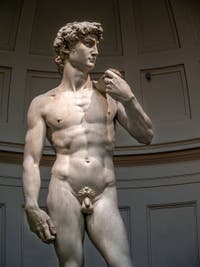
Michelangelo David The Florentine government wanted to recreate citizens' unity by ordering public works to restore their confidence in their belonging to the community.
A gigantic David symbolizing the Florentine people.
In 1501, the Gonfalonier (head of government) Pier Soderini, and the Opera del Duomo (the rich and powerful brotherhood of wool responsible for Santa Maria del Fiore), revived the old project of installing a monumental statue of David on one of the foothills of the church.The David, an ambitious project, abandoned twice
This ambitious project had been abandoned twice due to a lack of mastery of the subject on the part of the artists.In 1464, the sculptor Agostino Duccio had gone to Carrara to choose a large block of marble exceeding the 5 metres long that he had sided on the spot to facilitate transport; when he arrived in Florence, he abandoned work in 1466 after having sketched a dress knot at the level of his subject's chest.
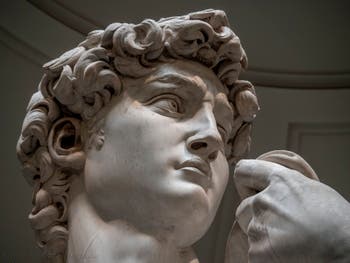
Michelangelo David A decade later, another sculptor, Antonio Rossellino, had given up in turn, declaring that it was necessary to use a particular technique to make such a monumental work.
A technique that has fallen into oblivion given that monumental statues had not been carved since Roman times.
And to complicate matters, the marble block had been thinned too much in some places by Duccio.
The marble of the future David had remained abandoned in the loggia del Duomo until Pier Soderini got it out of oblivion in 1501.
A risky project
Few artists dared to launch, except Andrea Sansovino, who thought she could make a beautiful work by adding a little material to places that were too busy.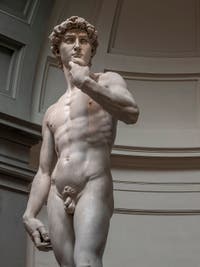
Michelangelo David However, we first wanted to know the opinion of Michelangelo just returned from Rome, where he had already shown immense talent by sculpting his Bacchus (Bargello) and his Pietà (St. Peter's Basilica in Rome).
Very flattered by the confidence shown in him by his fellow citizens, the young artist reassured them by specifying that he could exploit the marble piece without adding anything to it.
At the age of twenty-five, he was ready to overcome all the difficulties to create new works whose beauty would exceed their sponsors' dreams.
He had seen the monumental statues of the Dioscuri on the Quirinal hills in Rome, and he thought that the renouncements of the other sculptors were more due to lack of courage than to the forgetfulness of the technique to do these gigantic works.
Michelangelo facing the challenge: David against Goliath
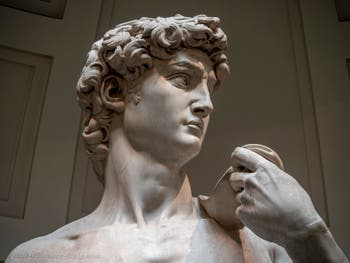
Michelangelo David It certainly took a lot of courage to dare to tackle a block of marble measuring more than five metres high with the means of the time. Still, it was also necessary to show ingenuity to draw a masterpiece from it knowing that it had already been started!
Michelangelo, the young sculptor who dared to take up such a challenge, was David against Goliath.
In September 1501, Michelangelo began a laborious work that would last for months without the slightest interruption or distraction, a body to hand, along with this enormous block of marble from which he would bring out the beauty.
The beauty of a young athlete combining strength and elegance.
Michelangelo began by making a clean slate by blowing up the dress knot sketched by Duccio.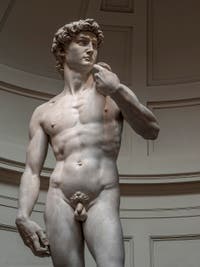
Michelangelo David When he worked at night, he lit up with a candle planted in the hole on top of a cone-shaped hat made from a thick sheet of paper wrapped around his skull.
Thanks to this trick, the light was focused on the area he was carving out.
Ambidextrous Michelangelo, the David with Two Hands
He cut his block on all sides at once by constantly moving from one to the other and, when his right hand could no longer hold the mallet, his left hand took over without losing the rhythm, a continuous work that allowed him to stay focused on his project.His David will play the musician shepherd who has never worn the breastplate or wielded the sword, but who does not fear to face the ferocious beasts with his bare hands to defend his sheep, the chosen one of God ready to throw his stone with such precision and force that it will kill his terrible opponent by piercing his forehead.
David, the biblical hero, will be a young athlete armed with his only sling, in the way that Hercules, the hero of Greek mythology with powerful musculature, was armed with a simple club.
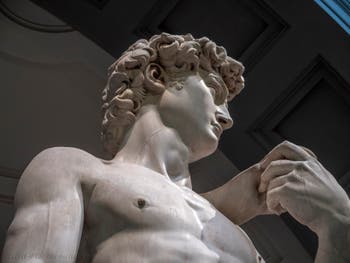
Michelangelo David David will be introduced to how the elders represented heroes and gods.
The Ancient Statuary Revisited by Michelangelo
Michelangelo appealed to ancient statuary but applying his own knowledge of human anatomy acquired during the dissections he had practised a few years earlier.The serenity and balance (contrapposto) that characterize ancient statuary can be read in David's attitude.
By grasping the sling resting on his shoulder with his left hand, he leans on his right leg, while his left leg is slightly bent and his right arm remains along the body are at rest.
The David: A Peace of Appearance
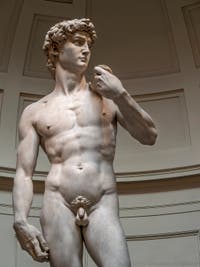
Michelangelo David This tranquillity is erased as soon as you notice the veins swollen by the tension of his right hand, whose fingers are folded over the stone that will kill Goliath.
We squeeze the strength and energy of the arm, ready to launch it.
And his head turned to the left, caused the muscles of the neck to swell; this is the decisive moment of this unequal duel that has become legendary, where courage and determination appear on his beautiful ephebe face with a hardened gaze under the brows frowned by concentration.
This is the moment when he risks everything to save his people.
These revealing details of David's state of mind were highlighted by the dimensions of the head and the hand holding the stone, a little large compared with the body.
However, the harmony of the whole remains in the eyes of the observer below.
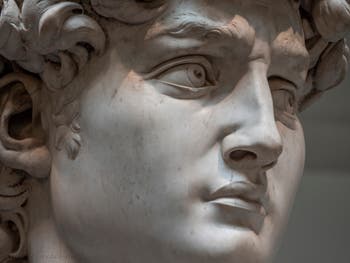
Michelangelo David
Alliance of Judeo-Christian mysticism with the aesthetics of ancient statuary
This statue, born from an alliance of Judeo-Christian mysticism with the aesthetics of ancient statuary, embodies the Christian king's ideal of combining strength and beauty.We know that Michelangelo would have given more relief to the musculature of the back of the marble block had not been thinned too much by Duccio.
Still, he had not been too worried about it since his statue had to be leaning against a buttress of the church of Santa Maria del Fiore.
David and Goliath | Michelangelo's Consecration
David David Goliath | Masterpiece | Consecration Pictures Pages: 01 | 02 | 03 | 04
Michelangelo David | Tomb Pope Julius II | Pietà - St. Matthew
Sculptors Michelangelo | Giambologna
Artists Sculptors | Painters | Music
Accademia Artists | Location | Opening Hours Tickets | Authorizations
Back to Top of Page

